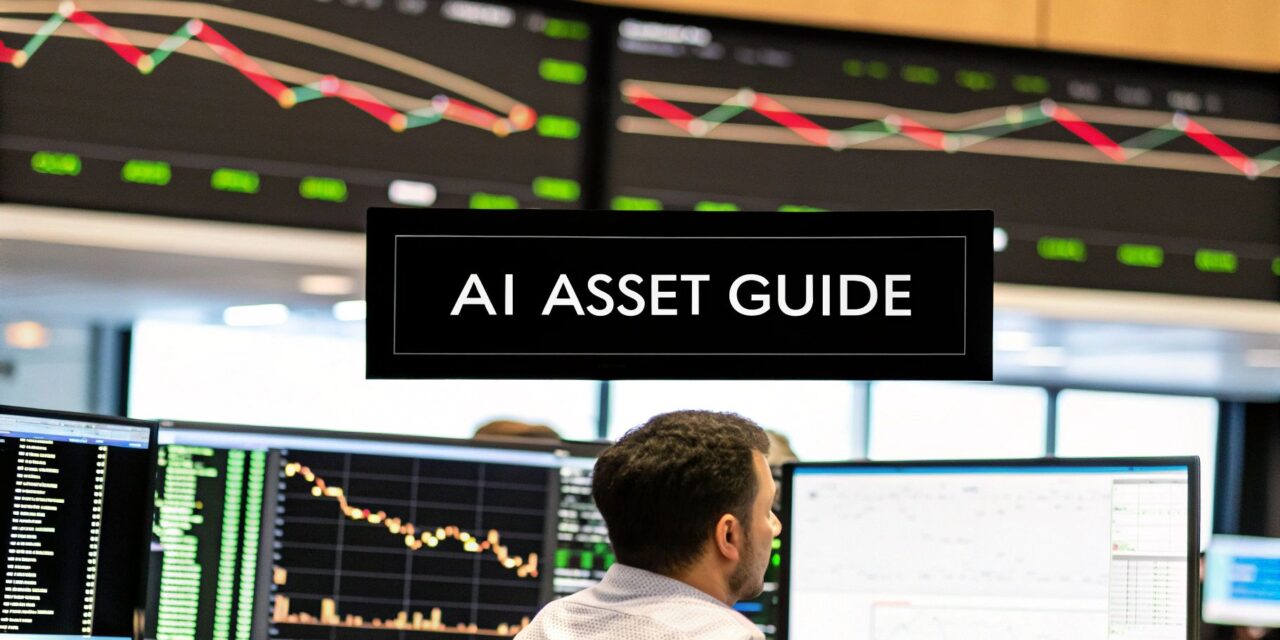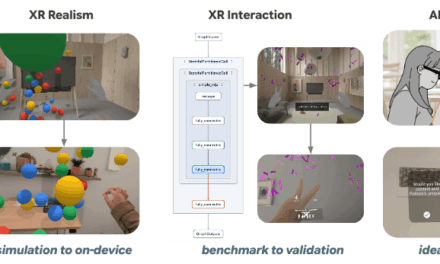Hey there! If you’ve heard the term "artificial intelligence in asset management," you might be picturing robots running Wall Street. The reality is a lot less sci-fi and a lot more helpful. Think of it as giving financial experts a super-powered assistant that can sift through mountains of data to help them make smarter, faster investment decisions. The goal isn't to replace people, but to give them incredibly powerful tools to elevate their work.
So, What Is AI In Asset Management Anyway?
Let's cut through the jargon. At its heart, artificial intelligence in asset management is about using smart technology to spot patterns, predict trends, and manage investments more effectively. It’s less about a robot making a gut decision and more about a human expert using a powerful tool to back up their intuition with hard data.
Imagine you're a portfolio manager. Before making a big investment, you'd want to read every financial report, news article, and social media post related to that company. That’s physically impossible for a person. But an AI system? It can scan, read, and understand all of that information in seconds. That's where its real value shines.
It’s More Than Just Automation
This isn't just about making old tasks faster; it's about doing entirely new things. Instead of just automating a trade, AI helps a manager understand why a particular trade might be a good move. It does this by connecting the dots between things that might seem unrelated—like a shift in consumer sentiment on Twitter and the performance of a retail stock.
As one industry expert, Dr. Alistair Finch, a data scientist at a leading fintech firm, puts it: "The core idea is to move from gut feelings and limited data to decisions backed by vast, comprehensive analysis. It’s about augmenting human intuition with machine-powered insights, not replacing it."
This fundamental shift is fueling incredible growth. The global market for artificial intelligence in asset management was valued at around USD 4.62 billion in 2024 and is expected to explode to USD 38.94 billion by 2034. That's not just a trend; it's a massive industry-wide pivot toward data-driven strategy. You can dig into the numbers behind this growth in a report from Precedence Research.
The Core Technologies Driving the Change
So, what's under the hood? A few key technologies are the engines making all of this possible:
- Machine Learning (ML): This is the brain of the whole operation. ML algorithms learn from historical data to recognize patterns and predict what might happen next. For example, a model could be trained on 30 years of market data to spot the subtle warning signs that often pop up before a market correction.
- Natural Language Processing (NLP): Think of NLP as the system's eyes and ears for human language. It allows computers to read and understand text. An asset manager could use NLP to instantly analyze the tone of a CEO's voice during an earnings call to gauge their confidence, or scan thousands of news articles for any mention of a specific company.
By putting these tools together, asset management firms get a much deeper, more nuanced understanding of the market. They can spot risks before they become crises and find investment opportunities that were once hidden in plain sight.
How AI Is Redefining Investment Strategies
Knowing what AI is in asset management is one thing, but the real magic happens when you see how it's actually used. This is where AI stops being a buzzword and becomes a powerful tool that’s actively rewriting investment playbooks. It’s all about making smarter, faster, and more informed decisions that can genuinely move the needle on performance.
This isn’t just about making small tweaks. AI brings entirely new capabilities to the table, giving managers a view of the market that was simply impossible before. From spotting the early signs of a market shift to customizing portfolios with pinpoint accuracy, the applications are real, practical, and growing every day.
This infographic gives a great visual breakdown of how core AI technologies, like Machine Learning and Natural Language Processing, are the engines powering these new strategies.
As you can see, these aren't just standalone tools. They're all part of a connected intelligence system that's at the heart of modern investment approaches.
Let's break down some of the most impactful applications. The table below summarizes the key areas where AI is making its mark, outlining the technology behind each application and the primary benefit it delivers.
Key AI Applications in Asset Management
| AI Application Area | Core Technology Used | Primary Benefit |
|---|---|---|
| Predictive Analytics | Machine Learning, Deep Learning | Forecasts market trends and identifies potential risks/opportunities ahead of time. |
| Algorithmic Trading | Machine Learning, Automation | Executes trades at high speed and volume with strategic precision, minimizing market impact. |
| Hyper-Personalization | AI-driven Algorithms, Data Analytics | Creates tailored investment portfolios based on individual client goals, risk, and values. |
| Sentiment Analysis | Natural Language Processing (NLP) | Gauges market mood by analyzing news, social media, and other text-based data sources. |
Each of these areas represents a significant shift in how investment decisions are made, moving from a purely human-driven process to one augmented by intelligent technology. Now, let's explore them in more detail.
Predictive Analytics: Forecasting Market Shifts
One of the most powerful uses of artificial intelligence in asset management is in predictive analytics. Think of it as a sophisticated weather forecast, but for the financial markets. Machine learning models sift through massive historical datasets—stock prices, economic reports, trade volumes, you name it—to find subtle patterns that tend to come before big market moves.
For instance, an AI might notice a tiny but consistent link between rising oil shipping costs and a dip in consumer goods stocks three weeks later. A human analyst, buried in spreadsheets, could easily miss that. But a machine can spot the correlation and flag the potential risk. These models are constantly learning, pulling in new data to make their forecasts even sharper. If you want a peek into the future of this field, it's worth understanding how time series foundation models are evolving.
Algorithmic Trading: Executing with Speed and Precision
Once you've spotted an opportunity, speed is everything. Algorithmic trading uses AI to execute trades at a pace no human could hope to match. We're talking about systems that can place thousands of orders in a fraction of a second, capitalizing on tiny price differences that vanish in the blink of an eye.
But it’s not just a raw speed game. These algorithms are also programmed with sophisticated strategies. A practical example is a technique called "iceberging," where an algorithm breaks up a massive order into smaller, almost invisible trades. This prevents the large order from spooking the market and driving up the price, ensuring the firm gets a better deal.
Hyper-Personalization: Crafting Unique Portfolios
Not long ago, a truly custom-built investment portfolio was a luxury reserved for the ultra-wealthy. For everyone else, it was an operational nightmare. AI has completely flipped that on its head.
"AI allows us to move beyond broad categories like 'aggressive' or 'conservative' and create portfolios that are truly unique to an individual's goals, risk tolerance, and even personal values," notes financial planner Maria Torres. "We can now offer mass personalization at a scale that was once impossible."
Robo-advisors are the most visible example. They use algorithms to build and automatically rebalance a portfolio based on how a client answers a few simple questions. This has opened the door for millions to access personalized financial advice. Even for traditional managers, AI helps by crunching thousands of data points for each client, ensuring every portfolio is perfectly aligned with their specific circumstances.
Sentiment Analysis: Reading the Market's Mood
Finally, AI is giving managers a way to get a handle on one of the most unpredictable forces in the market: human emotion. Using Natural Language Processing (NLP), specialized systems can scan news articles, social media feeds, and even the transcripts of corporate earnings calls to measure the overall mood around a stock, an industry, or the market as a whole.
Here’s how that plays out in the real world:
- Imagine a new electric vehicle company just launched its flagship car. An AI can instantly scan millions of tweets and online reviews.
- If it detects a wave of overwhelmingly positive comments about battery life and design, that could be a strong buy signal—long before the good news shows up in the next quarterly earnings report.
- On the flip side, a sudden spike in negative online chatter about product recalls could be the canary in the coal mine, warning of trouble ahead.
This ability to put a number on public perception gives asset managers a powerful, real-time indicator that adds a crucial layer of insight to their models.
Putting AI to Work: Real-World Success Stories
It’s one thing to talk theory, but seeing how artificial intelligence in asset management actually works in the real world is where it all clicks. The concepts are great, but the proof is in the results. So, let’s go beyond the hypothetical and look at how real firms are using this tech to get a serious leg up on the competition.
These aren't futuristic pipe dreams. We're talking about solving practical, everyday business problems right now. From protecting massive funds from market shocks to bringing financial advice to the masses, AI is already making a tangible difference.

From Billions in Risk to Pinpoint Precision
Picture this: you're managing a multi-billion dollar pension fund. The sheer scale of risk is staggering. One major global investment firm faced exactly this challenge. Their old risk models were okay, but they couldn't keep up with the chaotic speed of modern markets.
They brought in machine learning to build a smarter, more adaptive risk system. Instead of just looking at historical data, their new AI models constantly analyze a stream of live information, including:
- Live market data from global exchanges.
- Geopolitical news feeds and social media sentiment.
- A practical example of alternative data: satellite images tracking activity at major shipping ports to gauge global trade in real-time.
The AI wasn’t just spotting old patterns; it was learning to identify brand-new risk factors that a human analyst might never connect. The outcome? The firm could predict and hedge against volatility with far greater accuracy, safeguarding client capital. This shift from reactive to proactive risk management gave them a huge advantage. If you’re curious about the nuts and bolts of getting these systems live, our guide on successful machine learning model deployment breaks it down.
Making Financial Advice Accessible for Everyone
Now, let's look at the other end of the spectrum. A nimble fintech startup had a huge goal: make top-tier financial advice available to everyone, not just the super-rich. The roadblock was that traditional financial planning is labor-intensive and expensive.
Their answer was an AI-powered robo-advisor. This wasn't just a simple tool suggesting a few ETFs. It used complex algorithms to craft highly personalized investment plans. For example, it could factor in a user's goal of saving for a house in five years while also wanting to invest in socially responsible companies. The AI handled everything from building the initial portfolio to automatically rebalancing it.
"The real win here wasn't just the clever tech," the startup's CEO explained in an interview. "It was the impact. We could now offer bespoke asset management services for a tiny fraction of the traditional cost, tapping into a vast, overlooked market."
This is a perfect example of AI as a democratizing force in finance. It shows that the power of artificial intelligence in asset management isn't just for the giants of the industry.
Streamlining Due Diligence in Private Equity
In the high-stakes world of private equity, the due diligence process can be a brutal grind. Analysts spend weeks sifting through mountains of documents—contracts, financial reports, legal notes—just to find critical information. For one leading PE firm, this manual slog was a major bottleneck.
They adopted an AI solution built on Natural Language Processing (NLP). Instead of teams of people reading thousands of pages, the NLP model could scan everything instantly and extract crucial details like:
- Specific clauses buried in legal contracts.
- Revenue trends hidden in financial statements.
- Potential liabilities mentioned in tiny footnotes.
This didn't put their analysts out of a job. It freed them from grunt work, allowing them to focus on high-level strategic thinking. The firm saw a significant reduction in due diligence time, meaning they could evaluate more deals and move faster than their competitors.
The Tangible Benefits of Adopting AI
So, what's the real payoff? We’ve looked at how firms are putting AI into action, but let's dig into the concrete value this technology actually delivers. Bringing artificial intelligence into asset management isn't just about chasing the latest tech trend; it’s about unlocking serious, measurable advantages that give you a real competitive edge.
The benefits go way beyond simple cost-cutting. They touch every single part of an asset management firm, from the front-office teams making investment calls to the back-office handling compliance and daily operations. It’s about building a smarter, faster, and more resilient business from the inside out.
Superior Decision-Making Through Deeper Insights
Perhaps the most powerful benefit is the ability to just make better-informed decisions. Humans are fantastic at strategy and exercising judgment, but we all have a limit on how much information we can process. AI doesn't have that limit. It can chew through massive, unconventional data sources that were simply off-limits before.
Think about it this way: an AI model can analyze satellite images to track foot traffic at malls or count the number of container ships in a port to get a read on global trade. This kind of alternative data offers a real-time, on-the-ground view of economic activity, giving portfolio managers a heads-up long before official government reports are published. That leads directly to more proactive and accurate investment choices.
"AI’s true power in asset management is its ability to find the 'signal in the noise.' It elevates an analyst's intuition with evidence drawn from millions of data points, turning a good hunch into a data-validated strategy. This is how you gain a crucial advantage."
A Huge Boost in Operational Efficiency
Let's be honest, asset management is loaded with repetitive, time-sucking tasks. They're essential, but they don't add a lot of strategic value. AI is brilliant at automating these processes, which frees up your talented people to focus on work that actually moves the needle, like strengthening client relationships or developing new strategies.
Take routine compliance checks, for example. An AI system can instantly scan thousands of trades and internal communications to ensure they meet regulatory standards, flagging anything that looks off. This doesn't just save a staggering number of hours; it also dramatically cuts down the risk of human error.
A McKinsey analysis found that a mid-sized asset manager could achieve cost savings of 25% to 40% by automating workflows with AI. These savings come from smart deployment of AI agents to work alongside human teams, handling tasks across the entire business.
Improved Risk Management
In a world that feels more volatile by the day, managing risk is everything. AI offers a far more dynamic and forward-looking approach to assessing risk. Instead of relying on backward-looking historical models, machine learning algorithms can run thousands of potential market scenarios to pinpoint exactly where a portfolio is most vulnerable.
Here’s what that looks like in practice:
- Stress Testing: AI can run incredibly complex simulations to see how a portfolio would hold up during a "black swan" event, like a sudden interest rate shock or a geopolitical crisis.
- Early Warning Systems: The technology is great at detecting subtle market anomalies—the kind that often appear just before a major downturn—giving managers a chance to adjust their positions.
- Fraud Detection: AI algorithms are exceptionally good at spotting unusual trading patterns that could signal fraudulent activity, protecting both the firm and its clients.
This proactive approach to risk management helps safeguard client assets and ultimately builds a much more durable investment firm.
Navigating the Hurdles of AI Implementation
Adopting artificial intelligence in asset management isn't as simple as flipping a switch. While the potential payoff is huge, the path from concept to a fully functioning system is often paved with some very real challenges. Think of it like assembling high-end, flat-pack furniture—the picture on the box looks perfect, but you need to follow the instructions carefully to avoid ending up with a wobbly chair.
Thinking through these obstacles ahead of time is what separates a smooth rollout from a painful one. The firms that really nail this are the ones that map out a realistic plan, anticipating hurdles long before they become show-stopping roadblocks.

Unraveling Regulatory and Data Privacy Knots
One of the biggest tripwires is the dense web of regulations and data privacy rules. Finance is already a tightly controlled space, and dropping a powerful new technology like AI into the mix adds another layer of complexity. You have to be certain that every algorithm and data point meets strict standards like GDPR while safeguarding sensitive client information.
This isn't just a box-ticking exercise; it's fundamental to maintaining trust. In fact, a staggering 86% of firms admitted they were surprised by the regulatory and compliance headaches that came with AI. On top of that, 77% were worried about data privacy and whether they could trust the accuracy of the AI's output. You can dig into more of these industry-wide concerns in the full report from EY.
An industry veteran once told me, "Bring your compliance and legal teams into the AI conversation from day one. Treating regulations as an afterthought is the fastest way to make costly mistakes and lose the trust you've worked so hard to build."
The Initial Cost and Resource Investment
Let's talk about the elephant in the room: money. Getting a serious AI system off the ground takes more than just a software subscription. It requires a significant investment in the right tech infrastructure, high-quality data, and—most importantly—the right people.
That initial price tag can be intimidating, but you don't have to boil the ocean all at once. The smart move is a phased approach. Pick one high-impact area to start with—like automating a tedious reporting task—prove the value, and get people excited before you try to scale it across the entire organization. For a closer look at this process, check out our guide on the key steps to implementing AI in your business.
The Search for the Right Tech Talent
You can have the most advanced AI tools on the planet, but they’re just expensive paperweights without people who know how to use them. Right now, there’s a real talent crunch for professionals who can live in both the finance and data science worlds. You're looking for that rare individual who understands machine learning but also grasps the subtle complexities of asset management.
To get around this, successful firms are usually tackling it from two angles:
- Upskilling: They invest in training their existing financial analysts and portfolio managers on the fundamentals of data science and key AI tools. This builds a solid foundation of knowledge internally.
- Strategic Hiring: They bring in specialized data scientists and machine learning engineers who are genuinely interested in applying their skills to financial challenges.
This blend creates a powerful team where deep financial expertise and sharp technical skill can feed off each other, ultimately leading to far better results. Getting over these hurdles takes work, but with the right strategy and a clear-eyed view of the challenges, it’s absolutely achievable.
The Future of AI in Asset Management
Looking ahead, artificial intelligence in asset management isn't just going to get better—it's poised to become a core part of the operation. We’re moving beyond AI as a simple analysis tool and into an era where it helps with creation and end-to-end automation.
If today's AI is a skilled co-pilot, think of tomorrow's as the entire flight crew. It will handle a whole suite of complex, interconnected tasks with far less human oversight. This next wave of innovation is set to make the industry more predictive, personalized, and incredibly efficient. We're on the verge of AI becoming an active partner in the investment process, completely changing how managers work.
Hyper-Automation and Generative AI
The first massive shift we'll see is the rise of hyper-automation. This goes way beyond automating a single task. We're talking about linking multiple AI systems to manage entire investment workflows, from the initial idea all the way to execution.
Imagine an AI that not only spots a promising stock but then automatically drafts the initial research report, runs it through compliance checks, and executes the trade.
This capability will be supercharged by generative AI. Soon, AI won't just be crunching numbers; it will communicate what those numbers mean. For example, instead of just spitting out a performance chart, a generative AI could write personalized market commentary for each client, explaining their portfolio's performance in a clear, easy-to-read story. This deep level of automation will allow firms to operate at a speed and scale that was once unthinkable.
The Democratization of Advanced Finance
One of the most exciting long-term prospects is how AI could open up sophisticated financial strategies to everyone. For decades, complex, data-intensive investment methods were walled off, accessible only to large institutions with massive budgets and armies of analysts. AI is finally tearing down those walls.
"AI is leveling the playing field," says one fintech futurist. "In the near future, retail investors could have access to the same caliber of analytical tools and personalized strategies that were once exclusive to hedge funds. It’s the ultimate democratization of finance."
Picture a small-business owner using an AI-powered app that offers the kind of risk management strategies typically reserved for multi-billion-dollar portfolios. As these tools become cheaper and easier to use, they'll empower a new generation of investors. The future of artificial intelligence in asset management isn't just about making big firms bigger; it’s about making powerful financial tools available to everyone.
Your Questions About AI in Asset Management, Answered
It's completely normal to have questions when a technology like this moves so fast. The world of artificial intelligence in asset management is full of incredible possibilities, but it also brings up some valid concerns. Let's tackle the most common questions head-on.
Will AI Replace Human Asset Managers?
This is the big one, isn't it? The question on everyone's mind. The short answer is a firm "no." The industry consensus is that AI is here to augment, not replace, human expertise.
Think of AI as a world-class co-pilot. AI is phenomenal at crunching massive amounts of data and spotting patterns no human ever could. This frees up managers to do what they do best: build trusted client relationships, make nuanced strategic calls, and handle the uniquely human side of investing. It’s a partnership—the machine does the heavy data lifting, letting human insight and judgment take the lead.
How Can a Small Firm Start Using AI?
You don't need a Silicon Valley budget to get in the game. The easiest entry point for smaller firms is adopting specialized, third-party AI tools. You can find ready-made solutions for everything from market research and sentiment analysis to automated client reporting.
The trick is to start small with a specific, achievable goal. Don't try to boil the ocean. Pick one time-consuming back-office task you'd love to automate and start there. This lets you score a quick, measurable win, prove the value, and get your team comfortable with the new tech.
The journey to integrating AI is a marathon, not a sprint. A manageable starting point builds momentum and demonstrates value without a huge upfront risk.
What Are the Biggest Risks of Using AI?
While the upside is huge, you have to go in with your eyes open. The risks generally fall into three main categories:
- Data Security: AI systems are data-hungry, and that financial data is incredibly sensitive. Rock-solid cybersecurity isn't just a good idea; it's essential.
- The "Black Box" Problem: Sometimes, an AI's reasoning can be a mystery, making it tough to explain why it recommended a particular action. This can create serious accountability and compliance headaches.
- Model Bias: An AI is only as good as the data it's trained on. If that historical data has built-in biases (and most of it does), the AI will not only learn them but can actually amplify them.
Managing these risks comes down to strong governance, a relentless focus on transparency, and always keeping a human in the loop to sanity-check the machine's output.
Stay ahead of the curve with the latest insights and developments in AI. At YourAI2Day, we provide the news and tools you need to understand how artificial intelligence is shaping industries worldwide. Explore more at our official website.





